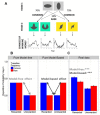How Accumulated Real Life Stress Experience and Cognitive Speed Interact on Decision-Making Processes
- PMID: 28642696
- PMCID: PMC5462964
- DOI: 10.3389/fnhum.2017.00302
How Accumulated Real Life Stress Experience and Cognitive Speed Interact on Decision-Making Processes
Abstract
Rationale: Advances in neurocomputational modeling suggest that valuation systems for goal-directed (deliberative) on one side, and habitual (automatic) decision-making on the other side may rely on distinct computational strategies for reinforcement learning, namely model-free vs. model-based learning. As a key theoretical difference, the model-based system strongly demands cognitive functions to plan actions prospectively based on an internal cognitive model of the environment, whereas valuation in the model-free system relies on rather simple learning rules from operant conditioning to retrospectively associate actions with their outcomes and is thus cognitively less demanding. Acute stress reactivity is known to impair model-based but not model-free choice behavior, with higher working memory capacity protecting the model-based system from acute stress. However, it is not clear which impact accumulated real life stress has on model-free and model-based decision systems and how this influence interacts with cognitive abilities. Methods: We used a sequential decision-making task distinguishing relative contributions of both learning strategies to choice behavior, the Social Readjustment Rating Scale questionnaire to assess accumulated real life stress, and the Digit Symbol Substitution Test to test cognitive speed in 95 healthy subjects. Results: Individuals reporting high stress exposure who had low cognitive speed showed reduced model-based but increased model-free behavioral control. In contrast, subjects exposed to accumulated real life stress with high cognitive speed displayed increased model-based performance but reduced model-free control. Conclusion: These findings suggest that accumulated real life stress exposure can enhance reliance on cognitive speed for model-based computations, which may ultimately protect the model-based system from the detrimental influences of accumulated real life stress. The combination of accumulated real life stress exposure and slower information processing capacities, however, might favor model-free strategies. Thus, the valence and preference of either system strongly depends on stressful experiences and individual cognitive capacities.
Keywords: chronic stress; cognitive speed; decision making; model-based learning; model-free learning; real-life events.
Figures



References
-
- Aster M. V., Neubauer A., Horn R. (2006). Wechsler Intelligenztest für Erwachsene WIE. Übersetzung und Adaptation der WAIS-III von David Wechsler. Frankfurt/Main: Harcourt Test Services.
LinkOut - more resources
Full Text Sources
Other Literature Sources
Research Materials

